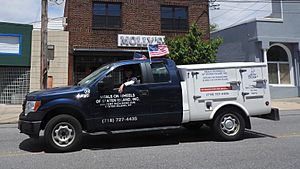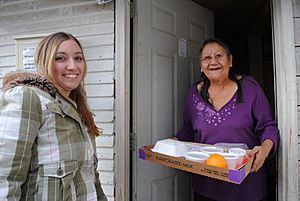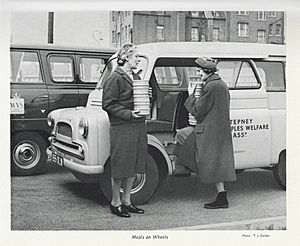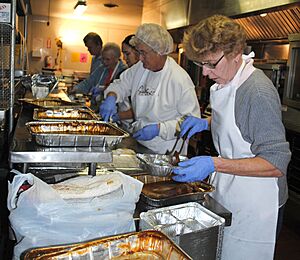Meals on Wheels facts for kids
Meals on Wheels is a special program that delivers warm, healthy meals right to people's homes. It helps individuals who find it hard to buy or cook their own food. Many people who receive these meals are older adults. Many of the kind volunteers who deliver the meals are also older, but they are active and can drive.
Studies show that these meal delivery programs really help people eat better. They also make sure people have enough food and feel happier. These programs can even save money for governments. This is because people who get meals at home might not need to go to hospitals or nursing homes as often.
How Meals on Wheels Started
Meals on Wheels began in the United Kingdom during World War II. This was around 1943, when many people lost their homes and couldn't cook for themselves. The Women's Volunteer Service (WVS) helped by providing food. The name "Meals on Wheels" came from how they delivered the food. They used prams, carts, bicycles, and cars – anything with wheels! Over time, this idea grew into the modern programs we see today. These programs mostly help older people who can't leave their homes. Sometimes the meals are free, or they cost a small amount.
First Deliveries in the UK
The very first home delivery of a meal on wheels happened in Hemel Hempstead, England, in 1943. Early services often used old baby prams to carry the meals. They even used straw or old hats to keep the food warm while traveling.
Today, many places in the UK have changed how they deliver meals. Instead of fresh, hot food, they often provide frozen meals that people can heat up later.
Meals on Wheels in Australia
Doris Irene Taylor started Meals on Wheels in South Australia in 1953. The first meal was served from the Port Adelaide kitchen in 1954.
In New South Wales, the Sydney City Council began its Meals on Wheels service in March 1957. In the first week, they served 150 meals to people living in the city center. These meals were cooked in the Town Hall kitchen.
Meals on Wheels is a very active group of organizations across Australia. In 2012, the Queensland branch of Meals on Wheels received a special award called the Queensland Greats Awards.
Meals on Wheels in Canada
The Red Cross Meals on Wheels program started in Canada in 1963. Elsie Matthews from Brantford, Ontario, had seen a similar program in England. She thought it would be helpful for her community. In its first year, the program delivered meals to 12 people each week.
Brampton, Ontario, also began delivering meals to seniors in 1963. A nurse named Ruby Cuthbert started the program. It began by delivering six meals a day.
In January 1966, women from a church in Westmount, Quebec, started their service. The idea spread to other communities in Montreal. Each group had to find money for food and volunteers to prepare and deliver meals.
Meals on Wheels in Ireland
The first meals in Ireland were delivered in Longford in 1971. County Longford Social Services organized this. The meals were given out from a special mobile kitchen. Local children helped raise money for this kitchen.
Some of the first meals were delivered by volunteers. The mobile kitchens were built by a local businessman. They had special gas cookers to keep the dinners warm. Meals were delivered to about 400 people, mostly older or disabled, and were free.
How Modern Programs Work
Today, Meals on Wheels programs usually work at a local level, like within a county. These programs can be very different in size and how they are run.
You can find Meals on Wheels programs in Australia, Canada, Ireland, the United Kingdom, and the United States. Most programs deliver meals that are hot and ready to eat. Some deliver cold meals that can be microwaved later. Others provide deep-frozen meals. Some programs even give an extra frozen meal before weekends or holidays when there are no deliveries.
Meals are delivered by paid drivers or by volunteers. Besides providing healthy food, the delivery person also checks on the client's safety. They can also offer a friendly chat, which is important for people living alone.
Most people who receive Meals on Wheels are older adults. However, others who cannot shop or cook for themselves can also get help. This can even include meals for their pets! In the United States, there is a program for people under 60 who are homebound. This program might require a doctor's note and a small fee. Most programs decide who gets meals based on whether they can get good nutrition, not on how much money they have.
Meals on Wheels in the United Kingdom
In Suffolk, UK, the program is called "Community Meals." These services help people who have trouble cooking for themselves. They can get daily hot meals, chilled meals, or weekly deliveries of frozen meals. The service in Suffolk is now run by Aspect Living Foundation. This is a charity that took over the service in 2018.
The Royal Voluntary Service also helps older people in the UK.
The National Association of Care Catering has a "Community Meals Week." This event helps people learn more about these services. In October 2008, Camilla, The Duchess of Cornwall helped with Meals on Wheels Week activities.
More and more, companies are providing meals instead of volunteer groups or local councils. Some local councils now deliver frozen meals instead of hot ones. In 2018, the traditional Meals on Wheels service was mostly stopped in the UK. However, frozen meal services and private hot meal schemes still exist.
Wolverhampton Council decided to expand its service. Now, anyone in the city can order Meals on Wheels. People can choose to get meals one day a week, every day, or for a set time, like after an operation. They can also get a cold "tea" (like a sandwich and fruit) with their hot meal.
In October 2011, a TV show called Meals on Wheels aired on BBC Two. The show helped campaign to save local Meals on Wheels services across the UK.
Meals on Wheels in Canada
Halifax Meals on Wheels in Nova Scotia has 68 programs across the province. More than 600 volunteers deliver about 3,400 meals each week. The city and the United Way help fund the service. Many meals come from nursing homes and hospitals. Some also come from restaurants and private homes.
The program is not just for older people. Anyone who lives alone and is recovering from a hospital stay can use it. People with disabilities who find cooking difficult also use the program. In 1996, over half of the clients in Halifax used the service for less than three months.
In 2020, Halal Meals on Wheels was created in Toronto. This program provides meals that follow Islamic dietary laws. It was funded by the United Way of Greater Toronto.
There are many independent Meals on Wheels groups in Montreal. One of the largest is Santropol Roulant. This group is run mostly by young volunteers. They deliver meals on foot, by bicycle, and by hybrid car.
Meals on Wheels in Ireland
Longford
As of 2016, vans are still used to deliver meals around Longford. Four vans deliver to all areas of County Longford. The meals are now hot soup and chilled main courses and desserts. People use microwave ovens to reheat the dinners. Meals are provided 7 days a week, every day of the year.
Other Areas
A study in 2008 found that most of Ireland has Meals on Wheels services. Many of these are registered charities. Half of the services only cover a single parish. Many more serve a slightly larger area.
Meals on Wheels in the United States
The first program like this in the United States started in Philadelphia in 1954. A social worker named Margaret Toy helped create it.
The Meals on Wheels Association of America (MOWAA) is based in Alexandria, Virginia. It is the oldest and largest group in the US that helps senior nutrition programs. MOWAA is a nonprofit organization. It works to improve the health and lives of older Americans by giving programs the tools they need. In 2016, Meals on Wheels provided about 218 million meals to 2.5 million Americans. About 500,000 of these people were veterans.

Citymeals-on-Wheels serves the New York City area. In 2008, Citymeals delivered over 2.1 million meals to more than 17,700 older adults. Over 1,500 volunteers spent many hours visiting and delivering meals. Gael Greene and James Beard started Citymeals-on-Wheels in 1981. They learned that many older New Yorkers had nothing to eat on weekends and holidays. They gathered support from restaurants to raise money. This money helped pay for meals on weekends and holidays, in addition to the weekday government-funded program.
In 2007, MOWAA studied hunger among older adults. In 2009, MOWAA worked with The Mission Continues. This group helps veterans who have served the United States.
There are also special Meals on Wheels programs, like "Kosher Meals on Wheels." These programs serve specific groups of people.
Study on Hunger Among Older Adults
The Meals On Wheels Association of America Foundation (MOWAAF) wanted to understand hunger among older adults in the United States. In 2007, they asked for a study called The Causes, Consequences and Future of Senior Hunger in America. The report was released in March 2008.
The study found that over 5 million older adults in the US sometimes did not have enough food. About 2.5 million were at risk of hunger. About 750,000 suffered from hunger because they didn't have enough money. Some groups were more likely to be at risk of hunger. These included people with lower incomes, those under 70, African Americans, Hispanics, and people living alone. However, hunger can affect people with different incomes and from all backgrounds.
Past Budget Discussions
In March 2017, there were discussions about cutting government money for programs like Meals on Wheels. Some officials questioned if the program was showing enough results.
Foodnet Meals on Wheels
Foodnet Meals on Wheels is an organization in Tompkins County, New York. It provides healthy meals and healthcare services for older adults. During the COVID-19 pandemic, Foodnet Meals on Wheels changed how they delivered food. They started an every-other-day schedule for home delivery. People received a hot meal and a frozen meal for the next day. They also offered nutrition advice and education over the phone.
Impact of Meals on Wheels
A study in 2013 looked at how home-delivered meal programs help people. It found that these programs greatly improved how well people ate. They also helped people get more nutrients and reduced the risk of not having enough food. Other good things that came from these programs included more chances for people to socialize. They also helped people follow special diets and improved their quality of life.
The study concluded that these programs help older adults stay independent. They can remain in their homes and communities as they get older or if their health declines. This also helps reduce the need for expensive nursing homes.
See also
- Food choice of older adults
- Meals on Wheels Association of America




